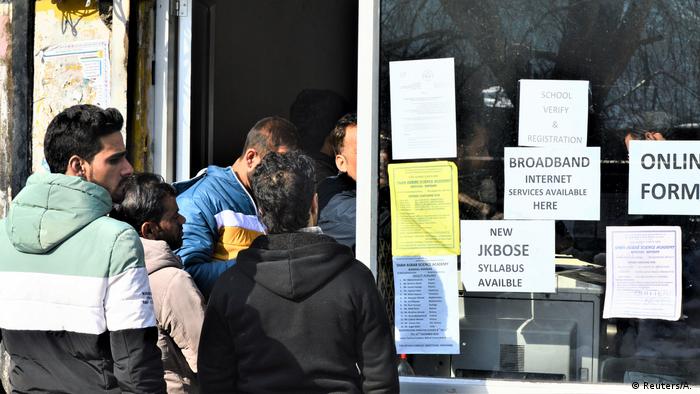[ad_1]
After seven months at the hours of darkness, folks in India-administered Kashmir once more have entry to the web and social media. However for entrepreneurs like Arifa Jan, the top of a enterprise promoting conventional Kashmiri carpets, also called Namda, the renewed entry is just too little, too late.
On August 5 of final yr, New Delhi stripped India-administered Kashmir of its restricted autonomy and imposed communications blackout.
For 33-year-old Jan, whose enterprise is dependent upon on-line consumers, that meant she needed to shut two of her manufacturing services as a result of loss in income.
Learn extra: Kashmiris really feel ‘alienated’ 6 months after India ‘annexation’
“After I closed my two items as a result of blockade, it meant that 53 folks, together with 28 ladies, misplaced their jobs,” she stated. “The web blockade paralyzed all the things as I misplaced monitor of my consumers.”
The seven-month web blockade in Kashmir was lifted on March 5. It had basically lower the area of from the skin world, leading to big losses for companies, hobbling well being care system, and ensuing within the closure of a number of info expertise companies.
The area suffered over $2.5 billion (€2.2 billion) in losses, in keeping with a report issued by the Kashmir Chamber of Commerce and Business (KCCI).
“This blockade has triggered irreversible injury to the economic system,” Sheikh Ashiq, who heads the KCCI, advised DW.
Web entry renews hope
Nonetheless, the restoration of the web, after one of many lengthiest suspensions anyplace within the democratic world, has supplied renewed hope to many.

Folks line up to make use of the web at a restaurant in Kashmir
Dr. Irfan Ahmad Bhat, a heart specialist on the Shri Maharaja Hari Singh Hospital (SMHS), one of many busiest hospitals in the primary metropolis of Srinagar, has spent the final three years working an emergency WhatsApp group referred to as the “Save Coronary heart Intiative,” which offers instantaneous knowledgeable recommendation to docs working in rural villages.
A day after the federal government eliminated the ban on social media use, Bhat acquired a message with an electrocardiogram (ECG) from a health care provider 160 kilometers (99 miles) away within the northern Kupwara village, the place a 63-year-old was hospitalized following a coronary heart assault.
Learn extra: India says web is being restored to Kashmir, however no social media
“Inside 5 minutes, we had been capable of advise the physician to provide the affected person a drug that may hold him alive till he was stabilized. It could not have been doable for him to journey to a tertiary hospital in time from a village so distant,” Bhat advised DW.
He added that within the three years of working the group, the specialists responding to the messages have analyzed greater than 36,000 ECGs.
Cardiologists like Bhat helped greater than 1,000 docs, some in villages as distant because the Line of Management (LOC), a demarcation line that divides Indian and Pakistani administered components of Kashmir.
Not getting access to the web put that lifesaving initiative on maintain, stated Bhat.
“Although the docs in these locations may handle half of such sufferers on their very own, the remaining couldn’t be managed (with out specialist recommendation),” he stated, including that within the final 5 days since that they had renewed entry to web, they analyzed 20 ECGs and assisted docs tending to seven totally different sufferers.
Misplaced alternatives
The web ban left not simply companies and well being care techniques reeling, but in addition people. For botanical researcher Javaid M Dad, the blackout meant shedding a world analysis alternative.
Dad, a senior analysis affiliate within the Division of Botany on the College of Kashmir, the area’s largest larger training establishment, was chosen to participate in a discussion board for younger scientists in Brazil final yr, however misplaced the chance to take part as a result of government-imposed web blockade.

Kashmiris protest in October
“When the discussion board realized that I used to be not capable of reply to emails, they posted a letter to my deal with, however I solely acquired it 4 days after the deadline had already handed,” Dad advised DW. “Regardless of my onerous work, I misplaced the chance to current my analysis paper,” he stated.
Learn extra: Kashmir awaits restoration of web with hope and skepticism
He had hoped to attend the BRICS discussion board, which incorporates specialists from 5 main rising nationwide economies, together with India and Russia, in July of final yr and was set to finish his visa software by September.
“Academically, it could have been an excellent alternative,” he stated. Moreover, he says that the present stage of web entry nonetheless cuts into his every day life, as cell web networks are nonetheless restricted to 2G speeds.
“On the college, I’m able to entry analysis papers and obtain materials. However I am not capable of get something completed on my cellphone. Even submitting a paper will not be doable,” he stated.
The communications and army lockdown was imposed in Kashmir — a territory over which India and Pakistan have fought two of their three wars — when the Indian authorities led by Prime Minister Narendra Modi’s right-wing Bharatiya Janata Occasion (BJP) revoked Article 370 of the Indian structure, a regulation that had protected the demography of the Muslim-majority area and barred outsiders from establishing everlasting settlements.
The federal government additionally divided the state into two territories — Jammu and Kashmir, and Ladakh — a transfer that triggered stress and outrage within the Muslim-majority area.
“We won’t get better all of those losses,” stated Ashiq. “Capital erosion has taken place.”
“The web ban ruined all the things,” stated Jan.
[ad_2]









